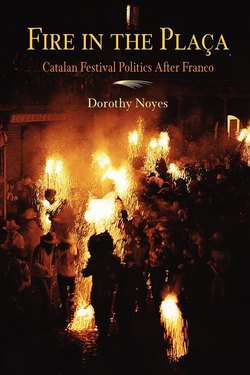Читать книгу Fire in the Placa - Dorothy Noyes - Страница 7
На сайте Литреса книга снята с продажи.
ОглавлениеA Note on Catalonia and the Catalan Language
ALTHOUGH BERGA IS WITHIN THE BORDERS of the state called Spain, it is linguistically and culturally part of Catalonia, which I am going to call a nation because the Berguedans do: it is an experiential unity felt as “home” of which a political expression is generally desired. The language of Catalonia is Catalan, a Romance language with a long literary tradition. Dialects of Catalan are spoken in Catalonia, the region of Valencia, the Balearic Islands, a fringe of Aragon along the Catalan border, the coprincipality of Andorra, the Department of the Pyrénées-Orientales in France (where more effective centralization has largely degraded the language to a patois), and the city of Alghero (Alguer) in Sardinia. These regions are collectively known as the Països Catalans. Catalonia proper—a triangle with the Pyrenees as one side, the Mediterranean as another, the Noguera Ribagorçana and Ebre rivers approximately marking the third, and Barcelona, the capital, in the middle—is now an autonomous region of the Spanish state. Catalan is its co-official language.
Catalonia has been fortunate in its native and foreign scholars, particularly in history and anthropology. Although I will cite several of them, I cannot do justice to the wealth of the scholarly tradition on which my own work depends. Readers interested in pursuing the subject have several fine collections in English with which to begin: McDonogh (1986), Llobera (1990), Azevedo (1991), and, in a more literary vein, Sobrer (1992).
I ask the reader’s patience with the Catalan words and phrases I have included. Many Berguedan things and practices do not translate gracefully into English—the plens, for example—and I imagine that the reader with some knowledge of Romance languages will like to see the real names and portions of original texts. I should note for readers of Catalan that I am following the Berguedan vernacular rather than the norms of Fabra: hence the presence of dialectal words such as àliga and Castilianisms such as petardos or Pepito.
Readers who are familiar with the much-documented sociolinguistic situation of Barcelona should be aware that the Catalan interior tends far more to monolingualism in Catalan. All of the current local media in Berga use Catalan; the language of administration is Catalan; the language of the street and of the home is Catalan. Castilian Spanish serves as a domestic language among first-generation immigrants, the language of literacy for working-class people educated under the dictatorship, and the primary language of access to the world outside Catalonia. All conversations reported or translated in this book are in Catalan; for the original language of translated texts, see the citations.
